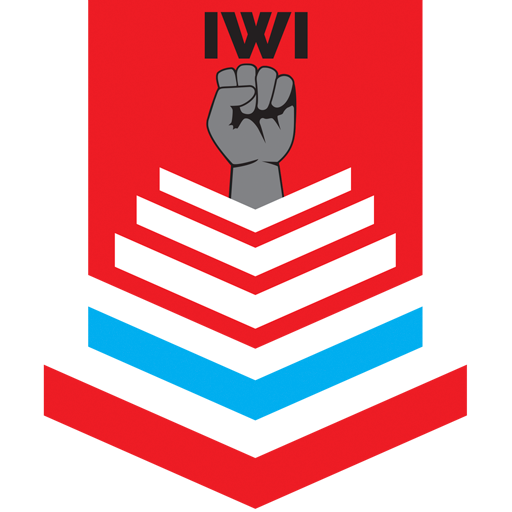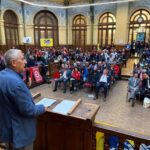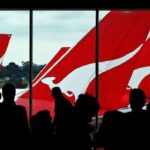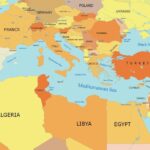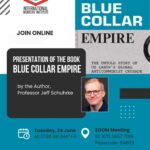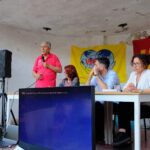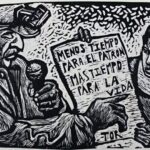On June 23, the IWI hosted a compelling online presentation of Jeff Schuhrke’s important book, Blue-Collar Empire: The Untold Story of US Labor’s Global Anticommunist Crusade. The book showcases how, for decades, the AFL-CIO expended their energies to block militant class consciousness from taking hold in the workers’ movements of Europe, Latin America, Africa, and Asia.
The event drew the participation of over 50 trade unionists and cadres from 22 countries, reflecting broad international interest in this critical history. Below, you can find videos, photos, and the main speeches from the event.

Alexandra Liberi (IWI Public Relations)
Dear colleagues and friends, thank you all for joining another important initiative of the International Workers Institute. I am Alexandra Liberi, Greek Trade Unionist and Public Relations Organizer of the Institute.
I know you are used to have our sister Anda host the events, but we must excuse her as she is attending another important trade union mission.
Before I give the floor to comrade Chris Townsend, from USA to introduce todays key speaker, I would like to take a minute to express our condemnation against the war unleashed by the zionist entity and the US Government against the people of Iran. There is no excuse and no flag big enough to whitewash an imperialist war. We know very well the reasons behind these war. On the one hand Israel is continuing its long plans towards a “Greater Israel” continuing the genocide of the Palestinian people, the attacks in Lebanon, in Yemen and together with the US and NATO allies, they fight full force for the race towards domination, raw materials, roads of commerce and seafare.
We the workers of the world need to have it clear. To demand the disarmament of nuclear weapons everywhere, especially USA, France, Israel who have the most of them, and world peace is a noble cause but those are empty words unless we give all our forces at the same time to build the front that will allow us to continue and complete the class struggle to achieve social change in favor of the working class and the masses. So that we can build our own country, however we want it and however we dream of it. Without exploitation or capitalist barbarism.
We cannot say it better than our poet Bertolt Brecht wrote:
THOSE AT THE TOP SAY: PEACE AND WAR
Are of different substance.
But their peace and their war
Are like wind and storm.
War grows from their peace
Like son from his mother
He bears
Her frightful features.
Their war kills
Whatever their peace
Has left over.

Chris Townsend (Member of the IWI EC)

Hello everyone, and thank you very much to the International Workers’ Institute and WFTU for inviting me to speak today about my historical research and about my book.
Blue-Collar Empire tells the story of US labor officialdom’s quest to control the workers’ movements of Europe, Latin America, Africa, and Asia between the 1940s and 1990s. It is important to understand that “the Cold War” was not only an East-West struggle between rival superpowers, but also a series of imperial, often grotesquely violent intrusions by the Global North into the Global South. The AFL-CIO’s international agents carried out their own imperial intrusions, expending incredible energy and resources to block revolutionary ideologies and militant class consciousness from taking hold in foreign labor movements.
In practice, this meant meddling in the internal processes of other countries’ unions, stoking internecine rivalries, creating and financially propping up splinter labor organizations, grooming cadres of conservative unionists, and occasionally using the power of the strike to sabotage left-wing governments. American labor officials usually carried out such activities without the full knowledge or approval of the rank-and-file union members they purported to represent. In the few instances where US unionists became aware of what their national leaders were up to in foreign lands, they forcefully protested.
Union activists, journalists, and scholars first began documenting US labor’s Cold War intrigues in the late 1960s, at the height of the Vietnam War. Early studies and exposés characterized the AFL-CIO as being little more than a puppet of the US government. The spotlight was especially shone on labor’s shadowy ties to the CIA. Many assumed the spy agency was corrupting hapless union leaders, while many others mockingly called the labor federation the “AFL-CIA.” More recent studies have demonstrated how the CIA was only the most notorious government entity that organized labor partnered with. In reality, the AFL-CIO became closely allied with almost the entire US foreign policy apparatus—not only the CIA, but also the State Department, the US Agency for International Development, and National Endowment for Democracy.
American labor officials were not mere dupes of the government, but instead were aggressive cold warriors in their own right. In striving for respectability and legitimacy over the years, the leaders of the American Federation of Labor (AFL) were often at odds with radicals within their own union ranks, making them increasingly defensive against leftist influence in the labor movement. This led to bruising internal union conflicts that helped shape the intense anticommunism of many twentieth-century US labor officials, many of whom spent their early years maneuvering to expel leftists from their own unions. They therefore did not need to be corrupted by the CIA, as they were willing to wage the Cold War with or without the government’s cooperation.
By the mid-1940s, the US labor movement had become entwined with the American state through the experiences of the Great Depression and two world wars. Becoming more reliant on the US government went hand-in-hand with surrendering collective power at the workplace. Labor officials therefore came out of World War II believing that maintaining the state’s favor, in part by demonstrating intense patriotism and hatred for foreign enemies, was crucial to the continued growth of their unions.
I begin the story in 1945, at the end of the Second World War. At that time, the labor federations of the Allied nations — including the American Congress of Industrial Organizations (CIO), the Soviet All-Union Central Council of Trade Unions, the British Trades Union Congress, the French Confédération Générale du Travail, and several others — sought greater cooperation with each other in the hope of strengthening working-class influence over economic and social policy in the postwar international order. They particularly sought to establish a new World Federation of Trade Unions (WFTU) to function as a kind of United Nations for labor.
Like the incipient UN, the proposed WFTU would include both communists and progressive noncommunists with different political systems and ideologies, but all with a shared opposition to fascism and commitment to multilateral diplomacy.
Notably absent was the American Federation of Labor (AFL) — the older and larger US trade union center — whose leaders vowed to boycott the WFTU because it included the Soviets. While the CIO had always been relatively tolerant of communists, and several of its affiliated unions were led by members or allies of the Communist Party USA, the AFL’s more conservative officials were uncompromisingly anticommunist, as they had been for decades.
As the CIO and the rest of the Allied nations’ unions were trying to build world labor unity, the AFL launched a new international arm in 1944–45 called the Free Trade Union Committee, which was determined to divide foreign labor movements into rival camps of communists and anticommunists. The term “free trade unionism” was used by the AFL as a synonym for anticommunist unionism. In other words, even if a union were autonomous and democratic, the AFL would still consider it illegitimate and “unfree” if it happened to be led or influenced by communists.
In the first few years after World War II, the AFL’s Free Trade Union Committee would deliberately provoke debilitating splits in the French and Italian labor movements along nascent Cold War battle lines, eventually becoming a willing partner and financial beneficiary of the Central Intelligence Agency (CIA).
At the same time, anticommunist hysteria overtook the United States. The 1947 Taft-Hartley Act—a law meant to restrict the further growth of unions—required that US union officials sign affidavits swearing they were not members of the Communist Party. The controversy over whether to comply with this requirement drove a wedge between the CIO’s communists and noncommunists. Similarly, the WFTU became divided over whether to support the Marshall Plan, Washington’s program to integrate postwar Western Europe into the emerging US-managed international capitalist system and sideline the region’s popular communist parties in the process.
In 1946, Walter Reuther — a young and ambitious union official — was narrowly elected president of the United Auto Workers. Eager to consolidate his control over the autoworkers’ union, Reuther proceeded to oust communists and their allies from union leadership positions, and soon began a campaign to rid the CIO of communists altogether.
In January 1949, in part thanks to Reuther’s influence, the CIO withdrew from the WFTU, ostensibly due to disagreements with the Soviet trade unions over the Marshall Plan. Alongside the AFL, British Trades Union Congress, and other Western-aligned labor federations, the CIO co-founded the International Confederation of Free Trade Unions (ICFTU) later that same year to be an anticommunist rival to the WFTU — officially killing the vision of postwar international labor unity. Soon afterward, the CIO expelled eleven of its communist-led unions, greatly weakening itself in the process. In 1955, the husk of the CIO was folded into the AFL, becoming the AFL-CIO.
With the World Federation of Trade Unions, communist and noncommunist labor organizations attempted to build the kind of international unity that might have served as a powerful rebuke to the Cold War, but the AFL and CIO tried sabotaging this vision.
Rather than a hapless victim of Cold War politics, then, American labor encouraged and exacerbated the Cold War. Wanting to see the success of the emerging, US-managed international capitalist order because they believed it would economically benefit their members, AFL and CIO officials essentially made the labor movement an appendage of Washington’s foreign policy apparatus by becoming willing partners of the State Department and CIA.
To offer one example from the book: After the 1949 Communist revolution in China, the AFL’s Free Trade Union Committee sent a representative to Taiwan. With resources provided by the CIA, the AFL representative established the “Free China Labor League,” which served as a front for espionage and sabotage activities. Teams of anticommunist Chinese agents secretly traveled from Taiwan to mainland China, where they not only reported intelligence back via radio transmitters, but also blew up fuel supplies (causing substantial civilian casualties) and attempted to stir up worker unrest in state-owned factories.
Through the Free Trade Union Committee’s China operation, the AFL became complicit in CIA-sponsored terrorist activities, straying far from its basic purpose of empowering workers.
Later, in the 1960s, the AFL-CIO further cemented its foreign policy alliance with Washington by creating new foreign “institutes” funded by the US Agency for International Development, to bring anticommunism to the labor movements of the Global South. The first, largest, and most consequential of these institutes was the American Institute for Free Labor Development (AIFLD), which was established after the Cuban Revolution to bring so-called “free trade unionism” to Latin America.
AIFLD trained hundreds of thousands of Latin American unionists in the ways of conservative business unionism, trying to buy their loyalty through development projects like the construction of low-cost worker housing. AIFLD and its trainees became important instruments of US imperialism in the region, working to push progressive political leaders out of power.
For example, AIFLD also played an important role in the US-backed military coup against Brazil’s left-wing president, João Goulart. Like their friends in the US government, AFL-CIO leaders believed Goulart was too close to the Brazilian Communist Party and needed to be ousted. In 1963, AIFLD’s training program hosted a special class of thirty-three Brazilian unionists. Their course included fifty hours’ worth of instruction on how to fight communist influence in their unions.
When the coup against Goulart was executed on April 1, 1964, the AIFLD graduates helped ensure it went smoothly. While leftist unionists called for a general strike to disrupt the coup, the US-trained union officials convinced their fellow workers to ignore these calls and allow the military takeover to proceed unobstructed. The new military regime put allegedly communist-led unions into trusteeships, sending “intervenors” — some of them AIFLD graduates — to purge these unions of leftists and Goulart sympathizers.
In the first days after the coup, an estimated 10,000 to 50,000 suspected leftists were arrested, including union members and student activists. At least many hundreds suffered brutal torture.
Three months later, an AFL-CIO official boasted in a radio interview that AIFLD’s Brazilian trainees “became intimately involved in some of the clandestine operations” of the coup. “Many of the trade union leaders — some of whom were actually trained in our institute — were involved in… the overthrow of the Goulart regime,” he said.
The criminal US war on Vietnam was a crucial turning point in the Cold War. Fought in the name of “containing” communism and modernizing South Vietnam, the war revealed to much of the American public the brutal and imperial nature of US foreign policy. The war opened new political space to challenge anticommunist orthodoxy in the United States, but AFL-CIO leaders would have none of this. Instead of using its economic muscle or close relationship with Washington to call for a swift end to the conflict, the AFL-CIO enthusiastically supported the war, even participating in it by aiding South Vietnam’s anticommunist labor leader, Tran Quoc Buu. The formal support of what was then one of the country’s largest mass membership organizations gave Presidents Lyndon Johnson and Richard Nixon political cover and helped allow the slaughter in Southeast Asia to continue, while domestic divisions over the war became ever more intense.
After the Vietnam War, journalists exposed more and more details about organized labor’s partnership with the US foreign policy apparatus, shocking many rank-and-file union members. But the AFL-CIO plowed ahead with its international intrigues, most notoriously by supporting the bloody military coup against socialist president Salvador Allende in Chile. This only further alienated a younger generation of more progressive rank-and-file union members who already felt that labor leaders were out of touch, undemocratic, and unwilling to fight the growing power of multinational corporations.
Meanwhile, amid increasing foreign competition, technological change, and upheavals in international finance, Corporate America moved to protect its profits in the 1970s by outsourcing jobs and offshoring production, accelerating a process of deindustrialization that would gut much of the AFL-CIO’s membership in the proceeding decades.
The AFL-CIO’s major focus in this period was not organizing new workers or listening to younger members, but joining with neoconservatives in reigniting superpower tensions in the face of détente. The AFL-CIO repeatedly demonstrated that it was an instrument for waging the Cold War first, and a vehicle to advance the lot of the working class second.
Partnering with Ronald Reagan—the most anti-labor US president in over fifty years—the AFL-CIO escalated its anticommunist crusade in the 1980s. With additional government funding through the newly created National Endowment for Democracy (NED), US labor intervened inside the communist world itself by financially supporting Solidarność in Poland. In the Philippines, the AFL-CIO’s Asian institute gave financial support to the corrupt and conservative labor federation that was tied to the Marcos dictatorship while trying to undercut the more militant and class-conscious trade union center—the KMU (May First Movement).
But when AFL-CIO officials went along with Reagan’s violent counterinsurgency policy in Central America, dozens of US union presidents and tens of thousands of rank-and-file members loudly protested.
These union dissidents were driven not only by a concern for the human rights of people in countries like El Salvador and Nicaragua, but also by a fear that Reagan’s efforts to crush progressive movements in Central America would only make it easier for US corporations to move production there. Indeed, by the end of the decade, Cold War anticommunism gave way to neoliberalism’s “race to the bottom,” with multinationals emboldened to move operations to wherever they found workers most exploitable. Celebrating the collapse of world communism, AFL-CIO leadership had no real plan for how to respond to this new geopolitical and economic reality.
For decades, American labor officials had been close partners of the US government in waging the Cold War around the world. While Washington’s foreign policy goals were often realized thanks to this arrangement, US workers ultimately did not benefit. The same federal government that generously gave the AFL-CIO hundreds of millions of dollars to interfere in foreign labor movements—supposedly in the name of “free” trade unionism—did little to promote union freedom at home. The anti-union Taft-Hartley Act was not repealed, labor law was not reformed to make it easier for American workers to join unions, the right to strike was not protected, and union jobs were not safeguarded from elimination. Instead, by the Cold War’s conclusion, Washington only made it easier for corporations to exploit workers both at home and abroad by facilitating free trade agreements like North American Free Trade Agreement (NAFTA).
In 1997, after the Cold War had ended and new leadership had taken control of the AFL-CIO, AIFLD and the other foreign institutes were shut down and reorganized into a new organization called the American Center for International Labor Solidarity, or Solidarity Center, which continues to be the AFL-CIO’s operational arm around the world.
Like its predecessor institutes, the Solidarity Center is primarily funded by Washington. Of its nearly $42 million in total support and revenue in 2020, $38.8 million came from federal grants, including $22.6 million from the NED and $14.9 million from USAID. Just $300,000 came from the AFL-CIO itself. Funding for the Solidarity Center’s programs has tended to mirror US foreign policy priorities. For example, when President George W. Bush invaded Iraq in 2003, the Solidarity Center simultaneously received $860,000 from the NED for its Middle East programs, up from $292,000 the year before. Or when the socialist Hugo Chávez was elected president of Venezuela in 1999 much to the concern of Washington, the NED’s annual funding for the Solidarity Center’s programs in that country suddenly jumped from $54,289 to $242,926. Soon after, the Solidarity Center was implicated in the failed coup attempt against Chávez in 2002.
Unfortunately, within the US labor movement there has been little to no discussion or debate about the Solidarity Center and its close ties to Washington.
If they are ever to be serious vehicles for strengthening and protecting the working class both at home and around the world in this era of overlapping crises, today’s AFL-CIO and its affiliated unions must adopt the kind of principled labor internationalism that would inevitably bring them into conflict with US foreign policy instead of reflexively serving it. But a labor movement that places class struggle and anti-imperialism ahead of deference to Washington’s international designs will not come into being unless workers build it ourselves.
Thank you.
See more photos below:


















